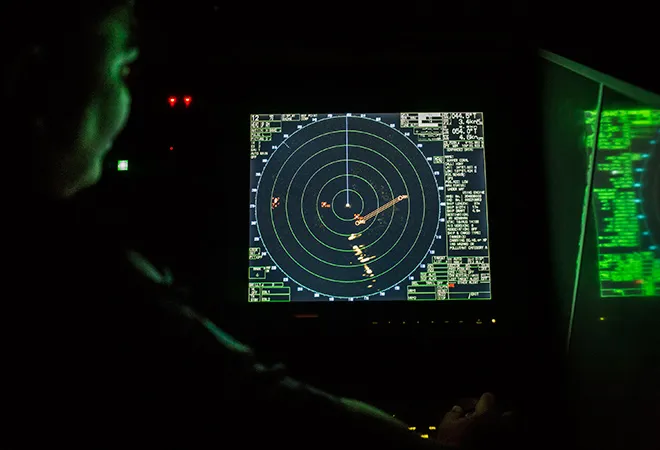
In August 2018, China and the Association of Southeast Asian Nations (ASEAN) reached an agreement over a single draft document to negotiate the proposed Code of Conduct (CoC) in the South China Sea (SCS) during the ASEAN-China Ministerial Meeting held on the sidelines of the ASEAN Foreign Ministers’ Meeting (AMM) in Singapore. The host of the meet Mr. Vivian Balakrishnan, Singapore’s foreign minister, hailed it as a “milestone” in the long drawn CoC process which has been crawling at a snail’s pace for more than 15 years. However, due to multiple interpretations of the text and lack of clarity on key issues, it could well prove to be another time-buying tactic for China to consolidate its strategic position in the South China Sea.
ASEAN first issued a statement regarding the SCS dispute in 1992 against the backdrop of the closure of US bases in the Philippines after the end of the Cold War. The immediate spark for the statement was China’s “territorial sea and the contiguous zone law” which claimed all the Spratly Islands and its accompanying territorial waters. <1> A couple of years later, the Philippines got alarmed when it discovered Chinese structures on the Mischief Reef, which Manila claims as its own. The AMM issued a strong statement in early 1995 urging the concerned parties to resolve the differences peacefully without the use of force. Sensing the gravity of the situation in the region, ASEAN decided to come up with the CoC in the SCS in 1996.
ASEAN first issued a statement regarding the SCS dispute in 1992 against the backdrop of the closure of US bases in the Philippines after the end of the Cold War. The immediate spark for the statement was China’s “territorial sea and the contiguous zone law” which claimed all the Spratly Islands and its accompanying territorial waters.
However, they took six long years to reach a compromise in the form of the “Declaration on the Conduct of Parties in the SCS” (DoC), 2002; let alone the CoC. There were multiple drawbacks with the DoC that was agreed upon by ASEAN and China. Firstly, it was non-binding and non-enforceable, and further, there was no provision to conclude the CoC in a time-bound manner. Moreover, the DoC was vague vis-à-vis the geographical scope and structures covered under it. <2>
The DoC also listed four confidence-building measures and five areas of cooperation to work upon until the final CoC was agreed upon. In 2004, a Joint Working Group (JWC) between ASEAN and China was set up to ensure that the provisions of the DoC get translated into concrete actions. The JWC came up with the guidelines to implement the DoC in 2011 <3>, and the discussions regarding implementation of the guidelines began in 2012. It was only in the next year, i.e., in 2013 that the formal discussion between ASEAN and China regarding the CoC began.
Interestingly, Article 5 of the DoC did not allow the parties involved to “inhabit the presently uninhabited islands, reefs, shoals, cays, and other features” in the SCS. In the face of this, China went on a spree to reclaim the uninhabited reefs and other disputed islands in the SCS at an unprecedented rate since 2013. This is when the Philippines knocked on the doors of the Permanent Court of Arbitration (PCA) at the Hague with the hope that they would be successful in reining in China’s expansionary moves in the SCS. However, China continued with the reclamation and converted the small reefs, which were part of the Spratly island chain, into a web of military bases with sophisticated support structures. It disregarded both, the provisions in the DoC that disallowed it from inhabiting uninhabited structures of the SCS, and the 2016 arbitration verdict of the PCA.
Nevertheless, it commenced a number of cooperative initiatives with ASEAN countries, such as expert committees on maritime scientific research, environmental protection, search and rescue, and transnational crime. In 2016, the “ASEAN-China Joint Statement on the Application of the Code of Unplanned Encounters at Sea in the South China Sea” <4> and the “Guidelines for Hotline Communications among Senior Officials of the Ministries of Foreign Affairs of ASEAN Member States and China in Response to Maritime Emergencies in the Implementation of the DOC in the SCS” <5> were also finalised. More recently, an ASEAN-China Maritime Exercise was agreed during the ASEAN Defence Ministers’ Meeting held in February 2018. <6> However, none of the initiatives could generate adequate confidence among enough ASEAN members due to their lack of trust in China.
In 2017, the foreign ministers of ASEAN and China adopted a framework on CoC, which was designed to act as a base for CoC’s actual negotiations. Although symbolically it marked a step forward in the conclusion of the CoC, the document failed to address the limitations ingrained in the DoC. <7> The first principle of the document mentioned that it was “not an instrument to settle territorial disputes or maritime delimitation issues.” <8> Moreover, it affirmed the necessity of monitoring mechanisms without powers to enforce the same. Building on this framework, ASEAN and China concluded the single draft document for further negotiations.
In 2017, the foreign ministers of ASEAN and China adopted a framework on Code of Conduct (CoC), which was designed to act as a base for CoC’s actual negotiations. Although symbolically it marked a step forward in the conclusion of the CoC, the document failed to address the limitations ingrained in the Declaration on the Conduct of Parties in the SCS.
It is thus far clear, that for the entire 16 years period since 2002, the Chinese have exhibited disregard for international law when it came to its actions in the SCS. Time and again, Beijing has used ‘negotiations’ as a lever to hold on to its position in the disputed environment. The current “milestone” regarding the CoC negotiations is yet another attempt to make regional players believe that China is serious about the conclusion of the CoC. However, a closer look at the single draft document tells us that vexed issues remain where they were since the commencement of the DoC in 2002 (See Table 1). The single draft remains non-binding, non-enforceable, and non-time binding. Its geographical scope remains vague. Although, it mentions international law, especially the United Nations Convention on the Law of the Sea (UNCLOS), 1982, it does not contain any provision to make the parties adhere to the same. Given the China’s non-acceptance of the PCA ruling in 2016, a binding provision was desirable. Like the framework on CoC, the single draft makes it clear that the final CoC won’t be a mechanism to settle the territorial disputes. Additionally, China has inserted articles to limit the role of external parties in any negotiations. Beijing has continuously attempted to exclude companies from the countries outside the region to participate in the projects related to the marine economy.
In diplomacy, it is said that on the negotiating table, the party which negotiates from the position of strength has a better chance to achieve the more favourable outcome. The stronger side is better positioned to impose its will on the weaker side either by way of negotiations or coercion. China is consolidating its position in the SCS by building artificial islands on the disputed features so that when the time to conclude the actual Code of Conduct comes, they will be at a far stronger position vis-à-vis the ASEAN. In the extreme scenario of a freeze on the island reclamation in a future agreement, though unlikely, China would be ready. Moreover, China is trying to improve its international image which was dented by its refusal to accept the arbitration ruling in 2016. Therefore, what Mr. Balakrishnan mentioned as a “milestone” in the CoC’s journey, is just a Chinese way to let the steam off, that is, to cool down high tempers temporarily.
Table 1: Comparison of the DoC, 2002; ASEAN-China Draft Framework Code of Conduct in the South China Sea, 2017 and ASEAN-China Single Draft South China Sea CoC, 2018.
| Issues/Agreements |
The Declaration on the Conduct of Parties in the SCS, 2002 |
The ASEAN-China Draft Framework CoC in the South China Sea, 2017 |
The ASEAN-China Single Draft South China Sea CoC, 2018# |
| Resolution of the dispute |
UNCLOS
The Treaty of Amity and Cooperation in Southeast Asia (TAC)
The Five Principles of Peaceful Coexistence
The universally recognised principles of international law |
UNCLOS
TAC
The Five Principles of Peaceful Coexistence
The universally recognized principles of international law |
UNCLOS
TAC
International means such as arbitration, judicial settlement, resort to regional agencies or arrangements, or other peaceful means decided by the parties concerned |
| Freedom of navigation and overflight |
Yes |
Yes |
Yes, but military vessels and aircraft enjoy sovereign immunity and are immune from the jurisdiction of any State other than the flag state |
| Cooperation mechanisms |
Holding dialogues and exchange of views as appropriate between their defence and military officials
Ensuring just and humane treatment of all persons who are either in danger or in distress;
Notifying, on a voluntary basis, other Parties concerned of any impending joint/combined military exercise
Exchanging, on a voluntary basis, relevant information.
Cooperation on marine environmental protection; marine scientific research; safety of navigation and communication at sea; search and rescue operation; and combating transnational crime, including but not limited to trafficking in illicit drugs, piracy and armed robbery at sea, and illegal traffic in arms |
Duty to cooperate
Promotion of practical maritime cooperation
Self-restraint/promotion of trust and confidence
Prevention of incidents
Confidence-building measures
Hotlines
Management of incidents |
Duty to cooperate
Promotion of practical maritime cooperation
Self-restraint/promotion of trust and confidence
Prevention of incidents
Management of incidents
Other undertakings, in accordance with international law, to fulfil the objectives and principles of the COC
Cooperation on marine environmental protection; marine scientific research; safety of navigation and communication at sea; search and rescue operation; and combating transnational crime, including but not limited to trafficking in illicit drugs, piracy and armed robbery at sea, and illegal traffic in arms
Notifying, on a voluntary basis, other Parties concerned of any impending joint/combined military exercise
Respect of the exercise of traditional fishing rights by fishermen… access to features and fishing grounds |
| Geographic scope |
Agreed upon by the Parties concerned prior to their actual implementation |
No mention |
Multiple perceptions by multiple countries |
| Legal status |
Not binding |
Not binding
Not an instrument to settle territorial disputes or maritime delimitation issues |
Not binding
Not an instrument to settle territorial disputes or maritime delimitation issues |
#The ASEAN-China Single Draft on South China Sea Code of Conduct is not available on the official website of the ASEAN. However, Carl Thayer accessed it and disclosed the content of the draft in the article “A Closer Look at the ASEAN-China Single Draft South China Sea Code of Conduct.”
<1> Max Herriman, “China’s Territorial Sea Law and International Law of the Sea,” Maritime Studies, 1997:92, 15-20, accessed on 3 September 2018.
<2> Clause 6 of the DoC stated — “The modalities, scope and locations, in respect of bilateral and multilateral cooperation should be agreed upon by the Parties concerned prior to their actual implementation.”
<3> “Guidelines for the Implementation of the DOC,” ASEAN Official Website, 2011, accessed on 3 September 2018.
<4> The statement can be accessed here.
<5> Mentioned in Chairman’s statement of the 19th ASEAN-China Summit in Laos.
<6> Siau Ming En, “Joint maritime field training exercise with Asean countries, China to be held in October,” Todayonline, 3 August 2018, accessed on 4 September 2018.
<7> “ASEAN China Draft Framework Code of Conduct in the South China Sea,” accessed on 4 September 2018.
<8> The ASEAN-China Framework CoC document.
The views expressed above belong to the author(s). ORF research and analyses now available on Telegram! Click here to access our curated content — blogs, longforms and interviews.




 PREV
PREV


